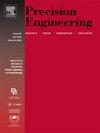镍磷合金的环保化学机械抛光研究
IF 3.7
2区 工程技术
Q2 ENGINEERING, MANUFACTURING
Precision Engineering-Journal of the International Societies for Precision Engineering and Nanotechnology
Pub Date : 2025-05-13
DOI:10.1016/j.precisioneng.2025.05.008
引用次数: 0
摘要
镍磷(NiP)涂层表面的切割痕迹会引起衍射和杂散光,对工件质量产生负面影响。借鉴化学机械抛光机理,采用环保型有机酸苹果酸代替强酸制备抛光液。然后,确定抛光溶液的最佳配方,以有效去除切割痕迹。利用本文提出的最优配方的环保型抛光液,对NiP涂层表面进行抛光,表面粗糙度在Sa中低于0.3 nm。x射线光电子能谱分析表明,H2O2氧化了NiP涂层表面,而苹果酸保持了溶液的酸性,提高了抛光效率。通过正交实验对抛光参数进行优化,得到了表面粗糙度为0.26 nm (Sa)的NiP涂层。本文章由计算机程序翻译,如有差异,请以英文原文为准。
Study on the eco-friendly chemical mechanical polishing of nickel–phosphorus alloy
Cutting marks on nickel–phosphorus (NiP) coating surfaces can cause diffraction and stray light, negatively affecting the quality of the workpiece. Drawing on the chemical mechanical polishing mechanism, malic acid, an environmentally friendly organic acid, is used to prepare the polishing solution instead of a strong acid. Then, the optimal formulation of the polishing solution is identified to effectively remove the cutting marks. Using the proposed environmentally friendly polishing solution with the optimal formulation, the NiP coating surface is polished to obtain a surface roughness below 0.3 nm in Sa. Analysis using X-ray photoelectron spectroscopy indicates that H2O2 oxidizes the NiP coating surfaces, while malic acid maintains the acidity of the solution and enhances polishing efficiency. Orthogonal experiments are conducted to optimize the polishing parameters, resulting in a surface roughness of 0.26 nm (Sa) on the NiP coating.
求助全文
通过发布文献求助,成功后即可免费获取论文全文。
去求助
来源期刊
CiteScore
7.40
自引率
5.60%
发文量
177
审稿时长
46 days
期刊介绍:
Precision Engineering - Journal of the International Societies for Precision Engineering and Nanotechnology is devoted to the multidisciplinary study and practice of high accuracy engineering, metrology, and manufacturing. The journal takes an integrated approach to all subjects related to research, design, manufacture, performance validation, and application of high precision machines, instruments, and components, including fundamental and applied research and development in manufacturing processes, fabrication technology, and advanced measurement science. The scope includes precision-engineered systems and supporting metrology over the full range of length scales, from atom-based nanotechnology and advanced lithographic technology to large-scale systems, including optical and radio telescopes and macrometrology.

 求助内容:
求助内容: 应助结果提醒方式:
应助结果提醒方式:


